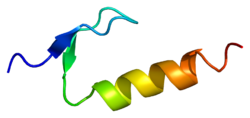DNA polymerase eta (Pol η), is a protein that in humans is encoded by the POLH gene.[5][6][7]
DNA polymerase eta is a eukaryotic DNA polymerase involved in the DNA repair by translesion synthesis. The gene encoding DNA polymerase eta is POLH, also known as XPV, because loss of this gene results in the disease xeroderma pigmentosum. Polymerase eta is particularly important for allowing accurate translesion synthesis of DNA damage resulting from ultraviolet radiation or UV.
- ^ a b c GRCh38: Ensembl release 89: ENSG00000170734 – Ensembl, May 2017
- ^ a b c GRCm38: Ensembl release 89: ENSMUSG00000023953 – Ensembl, May 2017
- ^ "Human PubMed Reference:". National Center for Biotechnology Information, U.S. National Library of Medicine.
- ^ "Mouse PubMed Reference:". National Center for Biotechnology Information, U.S. National Library of Medicine.
- ^ "Entrez Gene: POLH polymerase (DNA directed), eta".
- ^ Masutani C, Kusumoto R, Yamada A, Dohmae N, Yokoi M, Yuasa M, Araki M, Iwai S, Takio K, Hanaoka F (June 1999). "The XPV (xeroderma pigmentosum variant) gene encodes human DNA polymerase eta". Nature. 399 (6737): 700–4. Bibcode:1999Natur.399..700M. doi:10.1038/21447. PMID 10385124. S2CID 4429698.
- ^ Johnson RE, Kondratick CM, Prakash S, Prakash L (July 1999). "hRAD30 mutations in the variant form of xeroderma pigmentosum". Science. 285 (5425): 263–5. doi:10.1126/science.285.5425.263. PMID 10398605.





